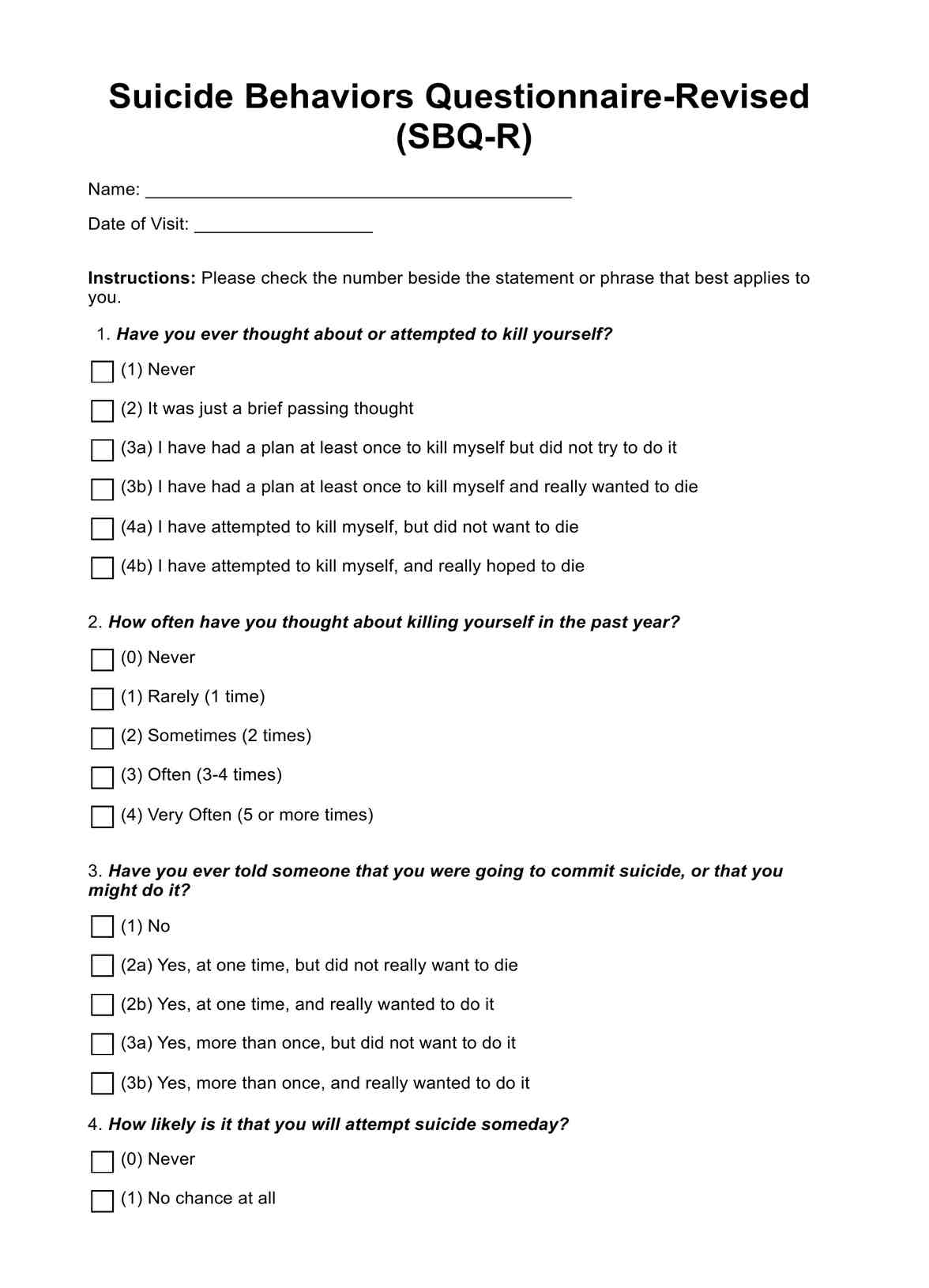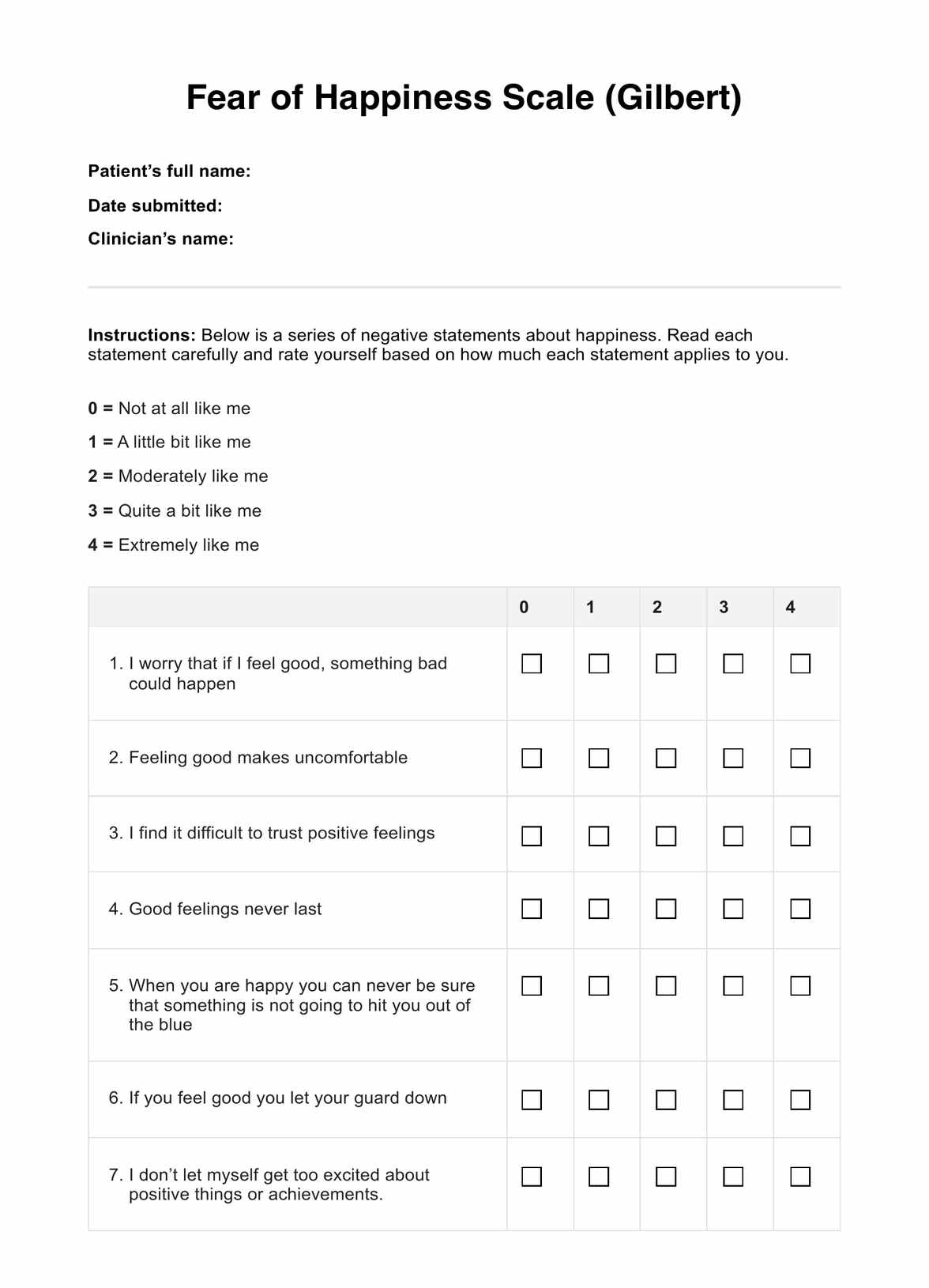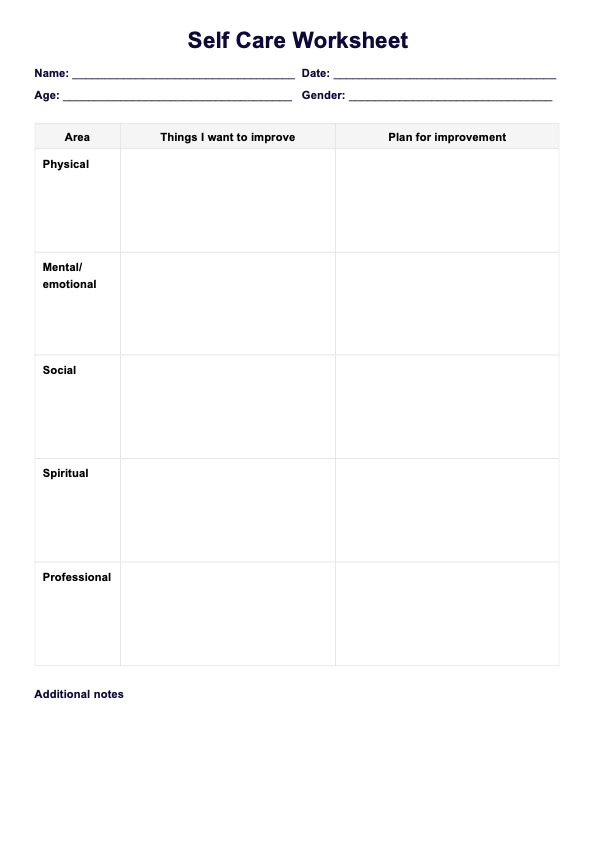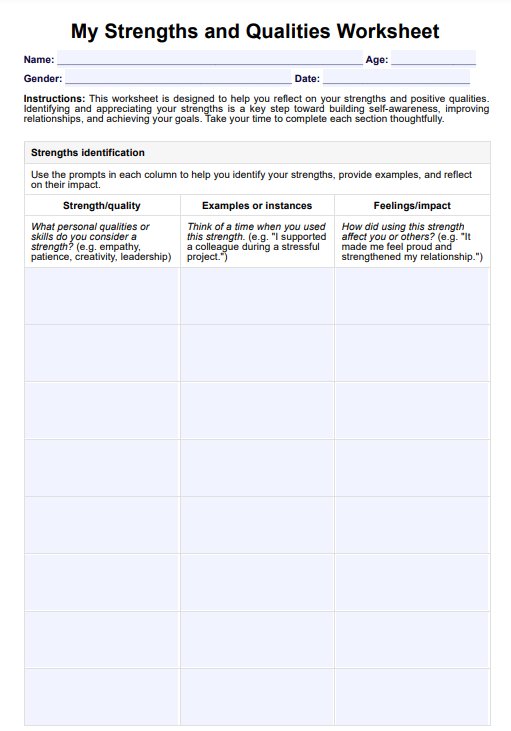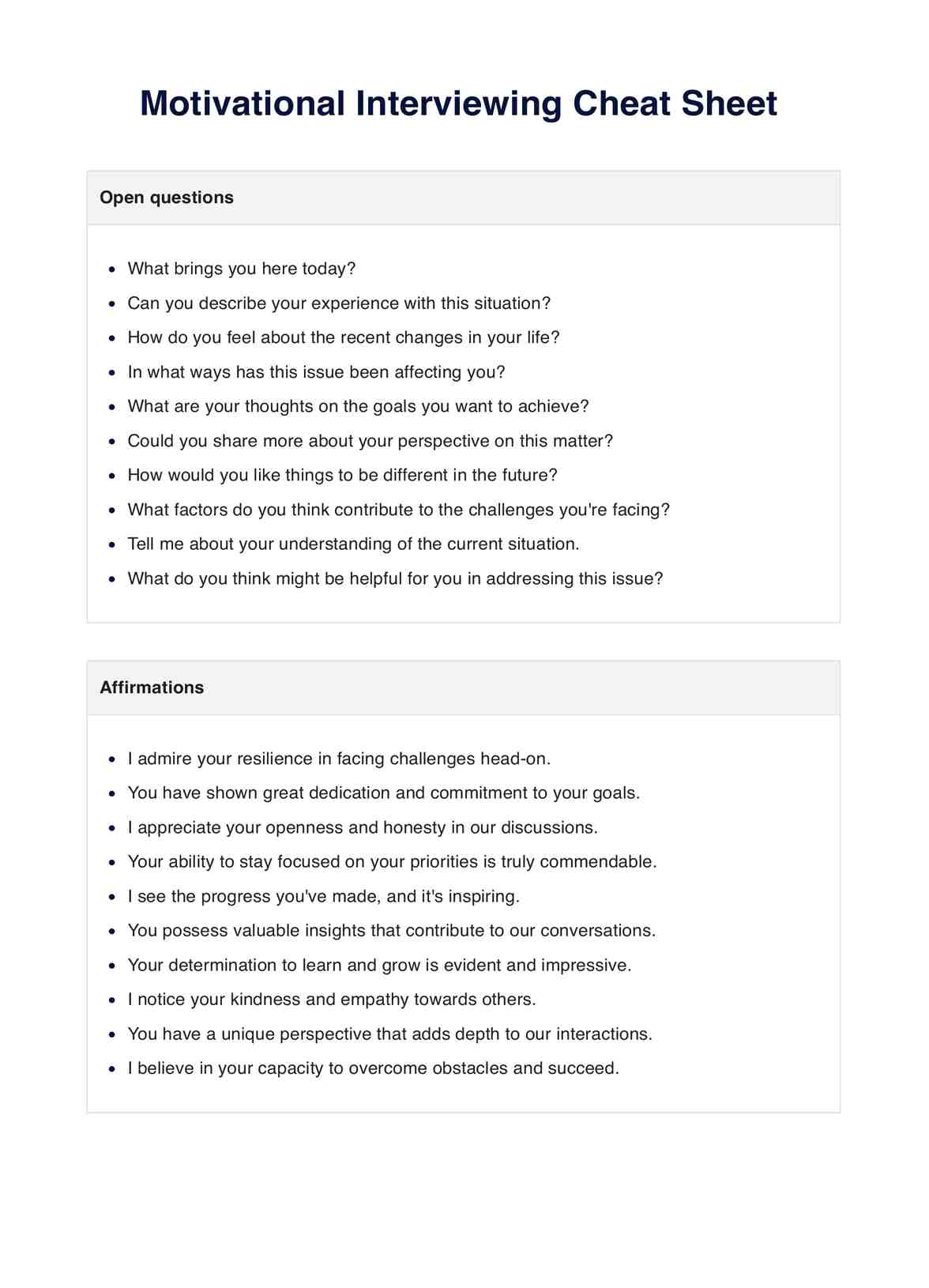Psychiatric Symptom Checklist
A psychiatric symptom checklist is useful for assessing and tracking mental health symptoms. Download a free PDF example from Carepatron now.


An introduction to psychiatric symptoms
Psychiatric symptoms encompass a wide array of emotional, cognitive, and behavioral manifestations that may indicate underlying mental health conditions. These symptoms are crucial indicators of an individual's psychological well-being and can significantly impact daily functioning. Understanding and recognizing psychiatric symptoms are vital steps toward seeking appropriate support and interventions.
Psychiatric symptoms can manifest in various forms, affecting thoughts, feelings, and behaviors. These may include but are not limited to:
- Mood changes: Fluctuations in mood, such as persistent sadness, irritability, or extreme highs and lows, can be indicative of mood disorders like depression or bipolar disorder.
- Anxiety: Excessive worry, fear, or restlessness may signal anxiety disorders. Physical symptoms like increased heart rate, trembling, and sweating can accompany these emotional experiences.
- Cognitive disturbances: Disorders may disrupt thinking processes, affecting memory, concentration, or decision-making abilities. These cognitive symptoms are often associated with conditions like schizophrenia or attention-deficit/hyperactivity disorder (ADHD).
- Behavioral changes: Observable alterations in behavior, such as social withdrawal, aggression, or changes in sleep and eating patterns, can indicate an underlying mental health America issue.
- Perceptual abnormalities: Hallucinations or delusions may occur, pointing towards conditions like schizophrenia.
Recognizing psychiatric symptoms is paramount for several reasons. Firstly, early identification facilitates prompt intervention and treatment, improving the prognosis for many mental health disorders. Secondly, understanding these symptoms helps in reducing the stigma surrounding mental health issues, fostering an environment where individuals feel comfortable seeking help.
A psychiatric symptom checklist is valuable for individuals, caregivers, and healthcare professionals. By systematically documenting and tracking these symptoms, patterns and trends can be identified, aiding in accurate diagnosis and tailored treatment plans.
Psychiatric Symptom Checklist Template
Psychiatric Symptom Checklist Example
When to assess your patients
Mental health professionals play a pivotal role in identifying and addressing psychiatric symptoms in individuals. The timely assessment of patients with mental health concerns is essential for early intervention and effective management of mental health conditions.
Here's a guide on when a mental health professional, including therapists and doctors, should assess patients and the role of psychiatric symptom checklists.
At the onset of symptoms
A mental health professional should proactively assess patients when symptoms first manifest. Early detection is crucial for preventing the escalation of mental health conditions. A thorough assessment is warranted if an individual exhibits mood, behavior, or cognitive functioning changes.
During regular check-ups
Incorporating psychiatric symptom assessments into routine check-ups is an effective practice. Even without overt symptoms, regular evaluations can help identify subtle changes and provide a baseline for comparison over time. This approach promotes a proactive stance in addressing mental health concerns before they become more severe.
Following significant life events
Major life events such as loss, trauma, or significant changes in personal circumstances can trigger or exacerbate mental health issues. Mental health professionals should be particularly attentive during these periods, utilizing psychiatric symptom checklists to gauge the impact of such events on an individual's mental well-being.
As part of comprehensive diagnostics
When patients present with symptoms that may indicate a mental health condition, a comprehensive assessment is crucial for accurate diagnosis. Psychiatric symptom checklists serve as valuable tools in this diagnostic process, aiding professionals in systematically gathering information about the nature and intensity of symptoms.
In response to treatment changes
Regular reassessment is essential, especially when patients change treatment plans or medications. Psychiatric symptom checklists help track the effectiveness of interventions and identify any emerging side effects or new symptoms that may require adjustments to the treatment approach.
How to use this Psychiatric Symptom Checklist
The psychiatric symptom checklist is a structured form designed to capture a wide range of symptoms associated with mental health conditions. It is a systematic tool for recording and monitoring changes in mood, behavior, cognition, and other relevant aspects of mental well-being.
Here are the steps to use the psychiatric symptom checklist:
Step 1: Familiarize yourself with the checklist
Begin by thoroughly reviewing the psychiatric symptom checklist. Understand the categories and specific symptoms it covers. Familiarity with the checklist ensures a more accurate and comprehensive recording of symptoms.
Step 2: Regular self-assessment
For individuals monitoring their mental health, perform regular self-assessments using the checklist. This step involves an honest reflection on one's experiences, identifying and documenting any changes or patterns in mood, behavior, or cognition.
Step 3: Consultation with mental health professionals
Share the completed psychiatric symptom checklist with a mental health professional during consultations. This step enhances communication, providing professionals with a detailed overview of symptoms and aiding in more precise diagnostics.
Step 4: Setting personal goals
Use the checklist to set personal goals for mental health improvement. Individuals can work collaboratively with a mental health professional to establish achievable goals and track progress over time by identifying specific areas of concern.
Step 5: Ongoing monitoring
Whether for individuals managing their mental health or for healthcare providers assessing patients, ongoing monitoring is crucial. Regularly update the checklist to reflect changes, improvements, or emerging symptoms, ensuring that interventions remain aligned with current mental health needs.
Steps after screening
After completing screening for psychiatric symptoms, taking proactive steps is crucial for the effective management and support of any mental health concern. Here are key guidelines to address mental health concerns and promote well-being.
Reflect on results
Take time to reflect on the screening results. Understand that the screening is a tool, not a diagnosis. If there are indications of potential concerns, it's essential to approach the results with openness and a readiness to seek further understanding.
Consult a mental health professional
If screening results suggest potential mental health issues, consult a mental health professional. They are trained to interpret and contextualize the results, providing a more accurate assessment. Professional guidance is crucial for understanding the severity of symptoms and determining appropriate next steps.
Recognize warning signs
Familiarize yourself with common warning signs of mental illness. Awareness of these warning signs can empower individuals and their families to identify serious problems early on. Mental Health America and other reputable resources offer valuable information on recognizing warning signs.
Involve family members and support networks
Share your screening results with trusted family members or friends. Involving a support network can provide emotional support and encouragement. Family members can play a vital role in encouraging further evaluation and seeking professional help.
Further evaluation and assessment
For those with concerning screening results or persistent symptoms, seeking further evaluation from mental health professionals is imperative. This step may involve comprehensive assessments of your mental health concern, diagnostic interviews, and collaboration with healthcare providers to establish an accurate diagnosis and treatment plan.
Treatment options
Upon the diagnosis of psychiatric symptoms, various treatment options become crucial in promoting mental health and well-being. Treatment choice depends on individual factors, the nature of the symptoms, and the severity of the condition. Here's an overview of different treatment options designed to address specific aspects of mental health.
Psychotherapy
Psychotherapy, or talk therapy, is a foundational element in treating psychiatric symptoms. This therapeutic approach involves engaging with a mental health professional to explore thoughts, emotions, and behaviors. It provides a safe space for individuals to understand the root causes of their symptoms, develop coping strategies, and work towards positive behavioral changes.
Medication
In some cases, medication may be recommended to manage psychiatric symptoms. Psychiatric drugs can help regulate neurotransmitters in the brain, alleviating symptoms of conditions such as depression, anxiety, or mood disorders. The decision to prescribe medication is based on a thorough evaluation of the individual's symptoms, medical history, and response to other treatment modalities.
Antidepressants
Antidepressants are a specific class of medications commonly prescribed to manage symptoms of depression and anxiety. They work by balancing neurotransmitters in the brain, enhancing mood stability. It's important to note that medication decisions should be made in consultation with a mental health professional. Young people, in particular, may require careful consideration of age-appropriate treatments and potential side effects.
Commonly asked questions
The symptom checklist in mental health is a tool used to systematically assess and record various symptoms associated with mental health conditions. It helps individuals, caregivers, and mental health professionals to identify, monitor, and communicate symptoms for a more comprehensive understanding of mental well-being.
The 90 R Checklist is a comprehensive self-report assessment designed to measure individuals' distress, discomfort, and mental health symptoms. It evaluates various domains, providing a nuanced understanding of an individual's psychological state.
Psychiatric symptoms encompass a broad range, including mood changes (e.g., persistent sadness), anxiety, cognitive disturbances (e.g., memory issues), behavioral changes (e.g., social withdrawal), and perceptual abnormalities (e.g., hallucinations). Identifying and recognizing these symptoms is crucial for early intervention and effective mental health management.


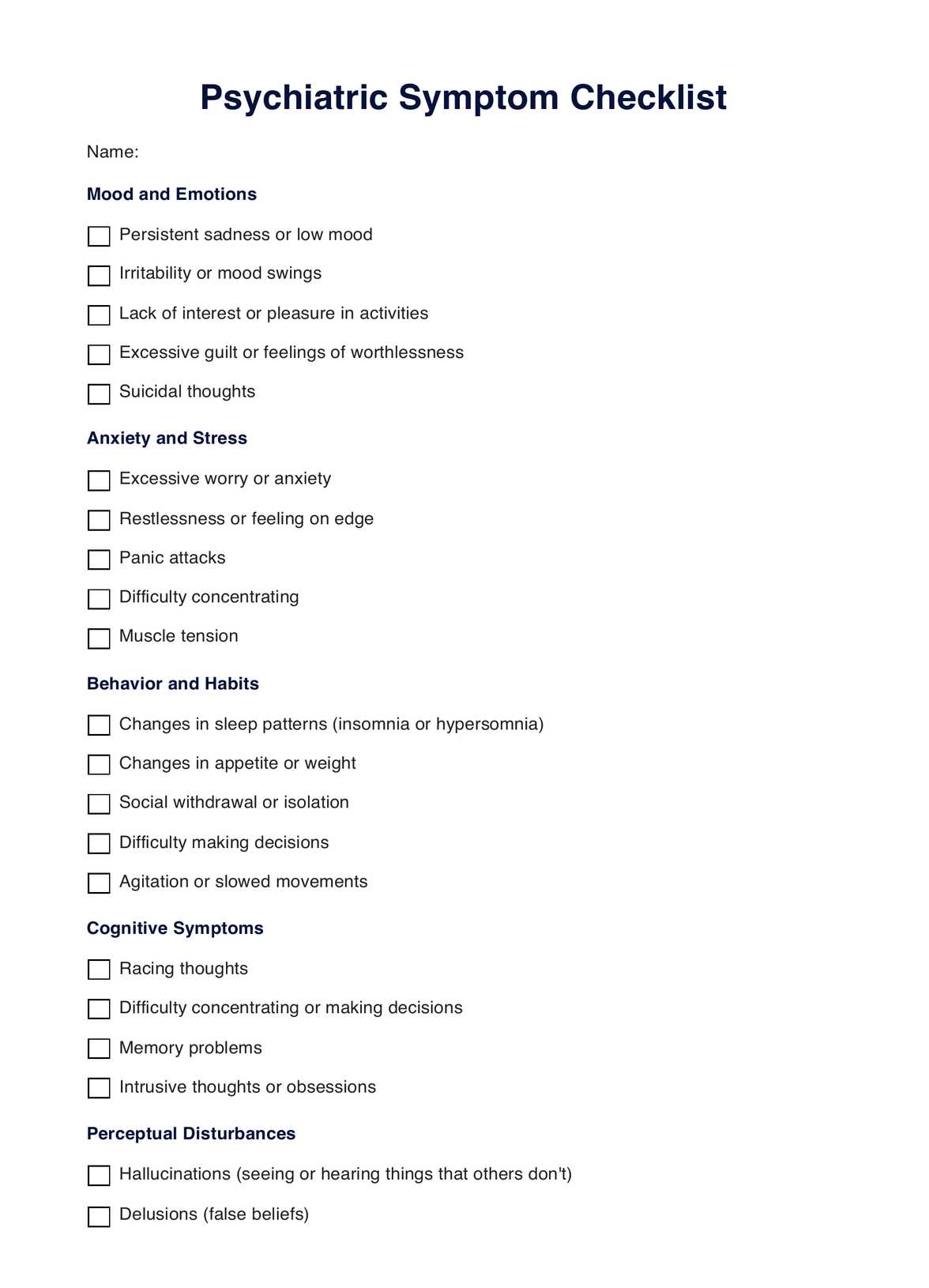
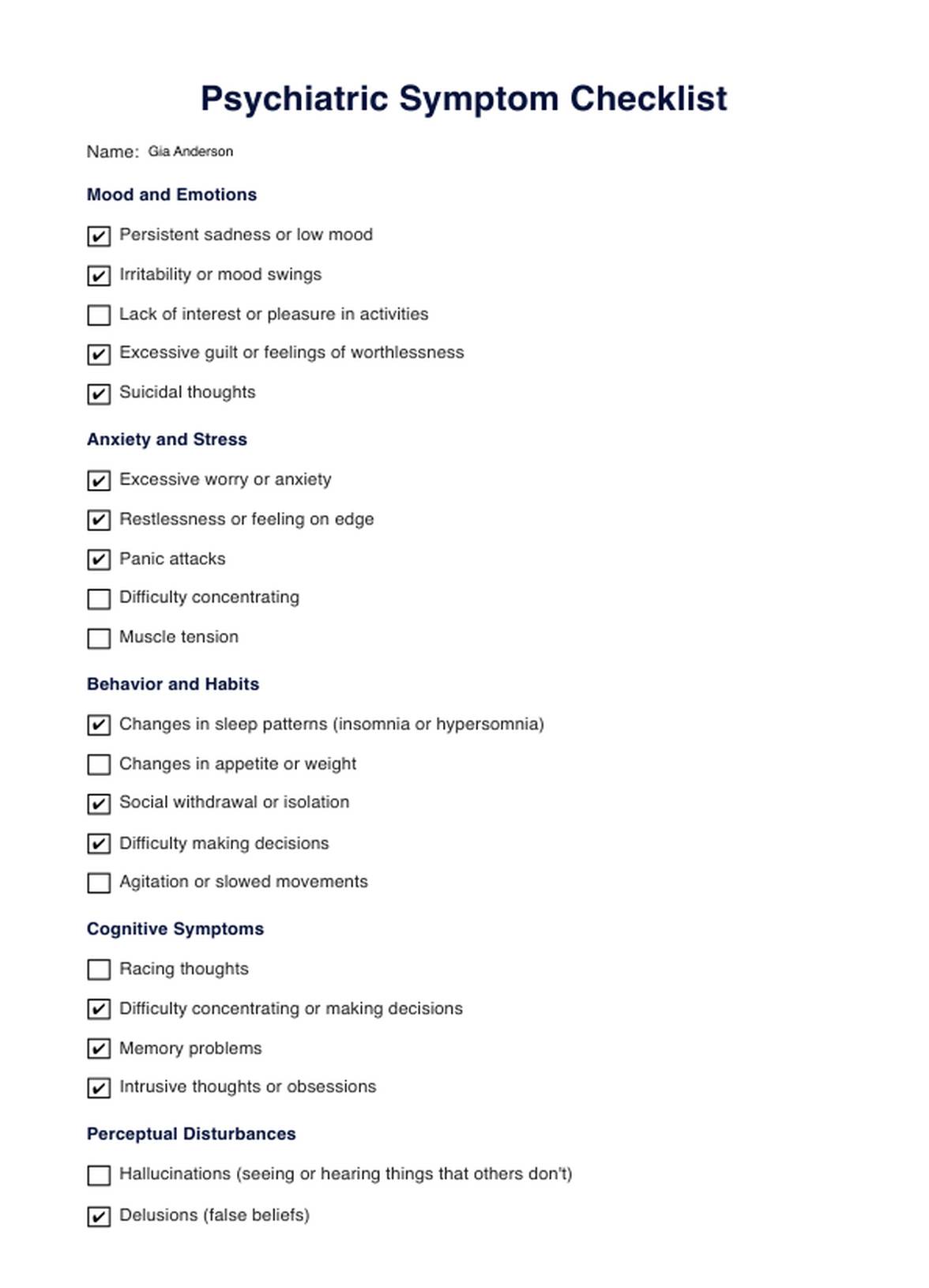

















-template.jpg)



















































































